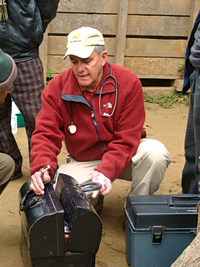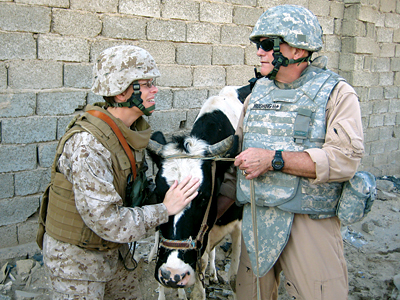His favorite animal is the cat. Not any cat but the big wild cat we know as the tiger. As a development professional, he believes that projects funded by foreign organizations should be “Nepali led and Nepali driven”. I question him about whether at any point in life as a wildlife vet, he has feared anything and even before I can finish, he cuts me off with “I do not have any fear.”
Did it intimidate me that I had set out to interview the USAID Mission Director? Certainly.
But as soon as I entered the door which was plastered with children’s illustrations, i heard music playing inside the room and spotted a witty wooden slab on the table with ‘Whatever’ written on it, I took a breather. Two minutes with the man himself, and any sign of nervousness that I had in me had melted away. Dr. Kevin Rushing exudes genuine warmth and immediately brings ease to whoever he is with. He also seems adept at how to befriend both, people and animals.
In his 28-year career with USAID, Dr. Rushing has established himself as a dedicated development professional and a passionate veterinarian – a rare combination. “When I am going out in the fields, I am wearing two hats. One as the USAID Mission Director and at the same time, someone very devout about protecting the biodiversity,” Dr. Rushing says.
 Rushing mentions that USAID is now hosting two projects – the tiger genome project and the ‘Hariyo Ban, Nepal ko Dhan’ project. “These are our major investments in protecting biodiversity and global climate change. We will be providing some resources to conduct the genetic fingerprinting of tigers in Chitwan and find out the actual count of tigers without putting the lives of tigers at risk. We will also be providing direct support to the government and working with the National Trust for Nature Conservation and its anti-poaching activities,” Dr. Rushing points out some aspects of the USAID projects. The projects are a clear sign of his drive to help animals and the environment because as he shares, when he got here in Nepal two years ago, no one was talking about doing anything for these issues.
Rushing mentions that USAID is now hosting two projects – the tiger genome project and the ‘Hariyo Ban, Nepal ko Dhan’ project. “These are our major investments in protecting biodiversity and global climate change. We will be providing some resources to conduct the genetic fingerprinting of tigers in Chitwan and find out the actual count of tigers without putting the lives of tigers at risk. We will also be providing direct support to the government and working with the National Trust for Nature Conservation and its anti-poaching activities,” Dr. Rushing points out some aspects of the USAID projects. The projects are a clear sign of his drive to help animals and the environment because as he shares, when he got here in Nepal two years ago, no one was talking about doing anything for these issues.
Wherever Dr. Rushing goes, he provides his veterinary services pro bono. When working in the Philippines, Dr. Rushing helped raise three Siberian tiger cubs, a Bengal tiger cub and an African lion cub in his own home. In Cambodia, he provided veterinary services to an international nongovernmental organization, WILDAID, to help stop the illegal trafficking of endangered species. In Ethiopia, he took care of several confiscated and injured wild animals that were too young to fend for themselves in the wild. Here in Nepal, one of the very first trips that Dr. Rushing made was to bring a tiger cub, Narayani, to the Central Zoo at Jawalakhel. Narayani had been rescued by villagers in Chitwan but she had been kept in a very small enclosure, restricting the tigress’ motion and proper care. Dr. Rushing jokes, “Narayani can still recognize me. When I visited the zoo recently, I went to meet Narayani. She let out a threatening growl – a warning to not come near her. She remembers that I had given her anesthesia.”
Dr. Rushing admits that working in Nepal has been one of his best assignments. “The counterparts that we have worked with – the government, the NGOs and all the other people – are simply great,” Dr. rushing says. “No one wants to credit the government for the good things that they do. In my experience, the government has been great,” he continues. Often times, the people I meet who have faith in Nepal and its potential are the ones who are foreigners. Dr. Rushing is also one such example. He believes in this country and its good people and looks out to creating more opportunities for them. However, he does say that the revolutionary change in mindsets and behavior of people as far as being conscious about the environment and the like will probably not happen in his generation. “The next generation of young people is the one that will bring about the change that we need. Hence, we need to educate them well,” he says.
 The fervent wildlife veterinarian went on to share some of his animal stories. First, he talks about Imy, the chimpanzee. On one of his visits to the Jane Goodall Institute Chimpanzee Orphanage in Burundy, there was a lot of chaos because Imy was let loose. “Now, Imy had the reputation of being the biggest, baddest and meanest female chimp. When she came towards our car, we were instructed to move out of the way and get inside our cars but instead, I got down on my knees and spread my arms. Imy came charging towards me and then jumped into my embrace,” Dr. Rushing recollects. “Imy has been in the sanctuary since 1993, I still keep checking on her,” he reveals his fondness for the chimp who would not let go of him for hours. A photograph of the same moment hangs on Dr. Rushing’s office wall along with other photographs of him with a baby elephant, a tiger cub and a boa constrictor. “I use that picture with Imy as my Christmas card,” Dr. Rushing points out.
The fervent wildlife veterinarian went on to share some of his animal stories. First, he talks about Imy, the chimpanzee. On one of his visits to the Jane Goodall Institute Chimpanzee Orphanage in Burundy, there was a lot of chaos because Imy was let loose. “Now, Imy had the reputation of being the biggest, baddest and meanest female chimp. When she came towards our car, we were instructed to move out of the way and get inside our cars but instead, I got down on my knees and spread my arms. Imy came charging towards me and then jumped into my embrace,” Dr. Rushing recollects. “Imy has been in the sanctuary since 1993, I still keep checking on her,” he reveals his fondness for the chimp who would not let go of him for hours. A photograph of the same moment hangs on Dr. Rushing’s office wall along with other photographs of him with a baby elephant, a tiger cub and a boa constrictor. “I use that picture with Imy as my Christmas card,” Dr. Rushing points out.
Next, we hear about the mongoose he woke up face to face with during his stay in Bangladesh. After that sudden encounter, he made friends with the mongoose, offering it food and even inviting it to sleep with him the following night. “The mongoose became my friend – one who would protect me from poisonous snakes,” says Dr. Rushing.
We also hear of a success story – where Dr. Rushing’s veterinary skills complimented and helped his professional work. When Dr. Rushing was in Iraq, there was a problem where the Al-Qaeda were recruiting widows. These widows’ pension had just been cut off, they had no source of income, no assets and had children to take care of. Taking advantage of this desperate situation, the Al-Qaeda was convincing the widows to strap bombs across their bodies and blow themselves off for money that would at least facilitate the needs of their children for some time. As a result of this, many widows were considering the option of becoming suicide bombers. To stop this, Dr. Rushing and his team established a small dairy co-operative which would allow the widows to generate some source of income. Dr. Rushing examined and bought several dairy cows and provided the widows with a herd of cows. Veterinary services, money for the feed and the other necessities were also provided to these women. The women directly sold the milk to the processing plants and earned a living.
 Dr. Rushing’s parents always knew that he was destined to be a vet. This fate was established after an incident with his parent’s friend’s dog when Dr. Rushing was only three years old. One day at his parent’s friend’s place, while the grown-ups were busy with a game of cards, baby Kevin was off somewhere. When his absence and the presence of an unfriendly and angry, 25-pound German Shepherd pet were put together, the adults panicked. But, to the surprise of the grownups, baby Kevin was tossing and turning and wrestling and playing with the dog who earlier, liked no one except the couple it was living with.
Dr. Rushing’s parents always knew that he was destined to be a vet. This fate was established after an incident with his parent’s friend’s dog when Dr. Rushing was only three years old. One day at his parent’s friend’s place, while the grown-ups were busy with a game of cards, baby Kevin was off somewhere. When his absence and the presence of an unfriendly and angry, 25-pound German Shepherd pet were put together, the adults panicked. But, to the surprise of the grownups, baby Kevin was tossing and turning and wrestling and playing with the dog who earlier, liked no one except the couple it was living with.
This assumption which was bound to be a reality was further supported by the various species of pets that Dr. Rushing brought home. Raccoons, rabbits, stray dogs, cats, lizards – there was a whole zoo in the garage. When the plastic veterinary kits first came out, Dr. Rushing had one for himself. He would engage himself in role-playing games and treat stuffed animals with his plastic stethoscope.
Over the years, of course, the stuffed animals and the plastic stethoscope have been replaced by their real counterparts but the love that Dr. Rushing has for animals has never been superseded.
“Narayani can still recognize me. When I visited the zoo recently, I went to meet Narayani. She let out a threatening growl – a warning to not come near her. She remembers that I had given her anesthesia.”










